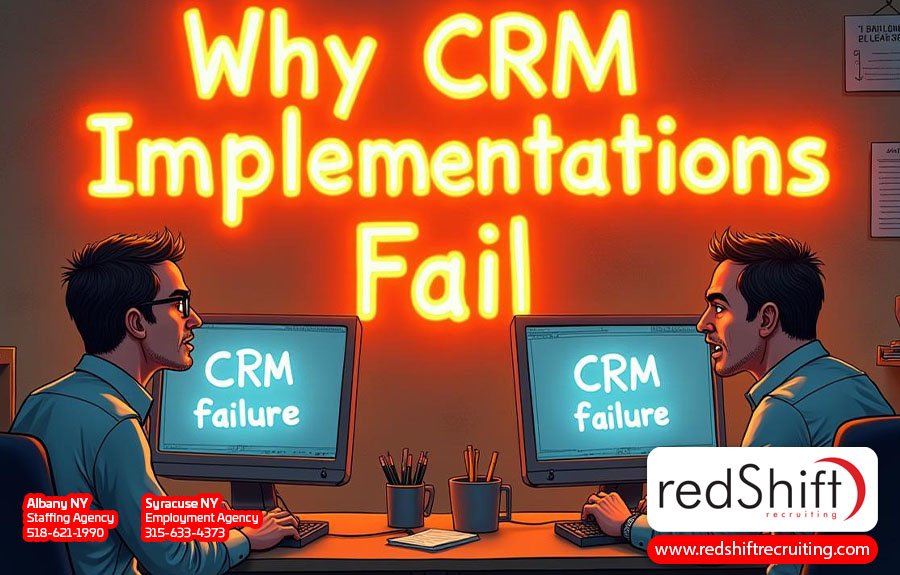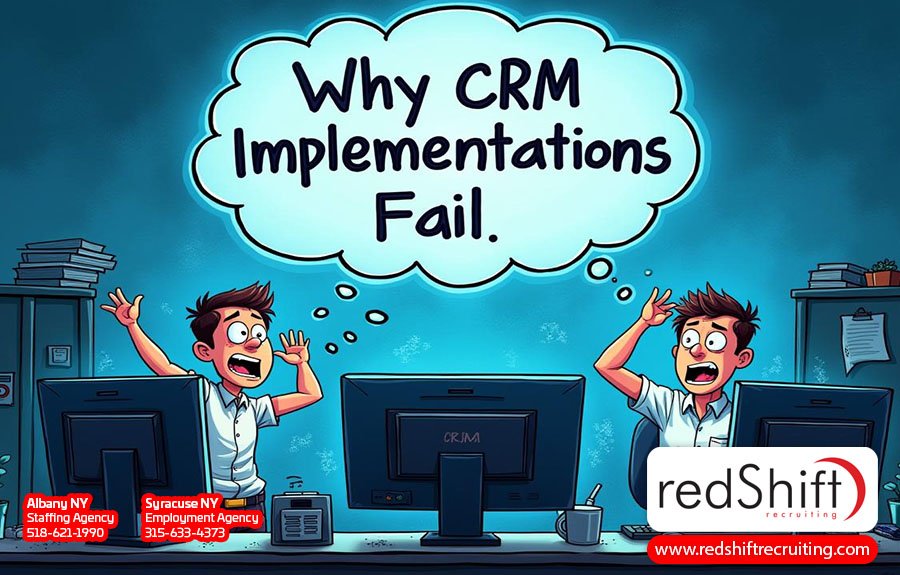Why CRM Implementations Fail (And How the Right IT Team Can Help)
CRM systems promise to revolutionize business operations, delivering benefits from improved customer retention to enhanced sales performance. However, the reality too often falls short, with studies reporting CRM failure rates ranging from 18% to as high as 70%. These failures leave businesses struggling with wasted investments and missed opportunities, frustrated by unmet expectations and stalled growth. So why do so many CRM projects fail, and what can businesses do to succeed? This article examines the most common reasons for CRM fails and how a skilled IT team can help your business navigate these challenges and unlock the full potential of your CRM system.
Understanding CRM Systems
A customer relationship management (CRM) system is a valuable tool for businesses with complex sales processes, growing customer bases, or a desire to improve customer relationships. By centralizing customer data, automating routine tasks, and offering valuable insights, CRM systems help streamline how businesses manage sales, marketing, and customer service. Whether tracking customer interactions or identifying trends to guide decision-making, a CRM acts as a central hub for improving efficiency and driving growth, making it adaptable for businesses of all sizes.
When implemented successfully, CRMs can transform how companies operate. From boosting customer satisfaction with personalized interactions to fostering better collaboration across teams, the benefits are clear. Businesses also gain the ability to make smarter, data-driven decisions that lead to increased revenue and long-term success. Additionally, many modern CRM systems integrate advanced technologies like AI and machine learning, offering features such as predictive analytics and automation tools that can help businesses identify new opportunities and improve workflow efficiency.
However, the path to a successful CRM implementation isn’t without its challenges. Complexities like managing data migration, coordinating across multiple teams, and ensuring employees adopt the system require careful planning and execution. The system must also scale to meet the evolving needs of the business, including growth in the customer base, changes in business processes, and the introduction of new products or services. Without addressing these factors, businesses risk missing out on the full potential of their CRM solution, leaving them with underutilized tools and unrealized goals.
Why CRM Projects Fail
Understanding why CRM implementations fail is essential for businesses to avoid costly mistakes and wasted opportunities. Common pitfalls include inadequate planning, poor data quality, and lack of user adoption, all of which can undermine the success of even the most sophisticated systems. From setting unclear objectives to selecting the wrong CRM vendor, each misstep can create ripple effects that derail a project, resulting in significant financial losses, wasted time, and damaged customer relationships. The following sections break down these challenges in detail, providing insights into the critical areas where CRM projects often go wrong and how businesses can address them.
Lack of Clear Objectives and Goals
One of the most common reasons CRM failures occur is the absence of well-defined, measurable objectives. A poor CRM strategy often results in vague goals like "improve relationships" or "streamline processes," which lack the specificity needed to guide implementation efforts. In contrast, clear CRM objectives provide actionable benchmarks, such as "increase customer retention by 10% within the next fiscal year through targeted email campaigns based on purchase history." Specific goals not only help align the CRM system with broader business processes but also foster stakeholder buy-in by demonstrating how the CRM supports the company’s priorities. This clarity motivates teams and sets the stage for effective implementation.
Insufficient user adoption is another consequence of unclear objectives, compounded by factors like inadequate training, a lack of perceived value for users, and poorly designed interfaces. When employees don’t understand the CRM’s purpose or find it cumbersome to use, engagement drops, and the system remains underutilized. To address this, businesses should treat goal-setting as a dynamic process, refining objectives as the project progresses and new insights emerge. Regular check-ins with key stakeholders throughout the implementation ensure goals stay relevant and aligned with changing needs. By defining clear, measurable objectives, securing stakeholder support, and leveraging IT expertise to translate these goals into actionable KPIs, businesses can position their CRM system for both immediate success and sustained growth.
Inadequate Planning and Execution
Insufficient planning and execution are major contributors to CRM implementation failure. When planning and estimating processes fail to account for the needs, workflows, and data requirements of multiple departments, misalignment between teams like sales and marketing becomes inevitable. Cross-departmental collaboration, supported by a dedicated project team or steering committee with representatives from each department, ensures all stakeholders' requirements are addressed, reducing silos that could undermine success. Overlooking risk management further exposes CRM projects to issues like budget overruns caused by unforeseen customization needs, timeline delays due to data migration challenges, or technical problems stemming from legacy system integration. Unrealistic timelines and inadequate resource allocation exacerbate these risks, often resulting in rushed execution and incomplete implementations. A well-thought-out plan that prioritizes alignment, anticipates risks, and allocates resources effectively is crucial to achieving success.
IT plays a pivotal role in managing system integration and ensuring compatibility through thorough, iterative testing. This includes unit testing, system testing, integration testing, and user acceptance testing (UAT), all of which help identify and resolve issues early in the process, preventing costly errors later. Transparent communication with stakeholders is equally vital, achieved through regular status updates, progress reports, and clear communication channels. These efforts not only maintain alignment but also build trust and adaptability throughout the project. By prioritizing robust planning, fostering cross-department collaboration, and leveraging IT expertise from the outset, businesses can overcome the complexities of CRM software implementation and lay the groundwork for sustained success.
Choosing the Wrong CRM System
Choosing the right CRM program is crucial for enabling an organization to manage customer interactions effectively and achieve its strategic objectives. A system that doesn’t align with the company’s business model can hinder growth and adaptability. For instance, a CRM designed for small businesses may struggle to support the demands of a rapidly expanding enterprise, while an enterprise-grade CRM may be unnecessarily complex and costly for a startup. Additionally, overlooking critical factors like security and compliance with regulations like GDPR, CCPA, or HIPAA can expose businesses to legal risks or penalties and erode customer trust. User-friendliness is equally vital, as overly complex or cumbersome systems that include unnecessary features not only increase costs but can also overwhelm users, leading to lower adoption rates and reduced efficiency. Importantly, what constitutes “user-friendly” should be evaluated by representatives from the actual user groups to ensure practicality. Focusing on functionalities that meet actual business needs ensures the CRM remains practical and accessible for the organization.
Organizations must also assess the total cost of ownership (TCO), factoring in licensing fees, implementation expenses (e.g., data migration, configuration), customization, and ongoing maintenance. A vendor’s ability to provide reliable support, regular updates, and adherence to Service Level Agreements (SLAs) should also weigh heavily in the decision-making process.
IT’s involvement is essential in selecting a scalable CRM solution that meets technical requirements, including integration capabilities (e.g., APIs, webhooks), data storage needs, and security protocols. Pilot programs that test the CRM with real-world data and workflows can reveal potential issues, gather feedback from users, and refine implementation strategies before fully committing. Simplifying the user experience through thoughtful customization by IT can balance functionality with usability, making the system easier for teams to adopt and use effectively.
Choosing the Wrong Vendor
Selecting the right CRM vendor or implementation partner is essential to the success of most CRM implementations. Choosing a vendor whose offerings don’t align with your organization’s specific needs can result in limited functionality, poor integration with existing systems, and insufficient scalability. The vendor’s solutions should support your business strategy across key areas like marketing automation, customer engagement, sales force automation, customer service, and analytics. Additionally, assessing the vendor’s longevity, financial stability, and market reputation is critical to ensuring they can provide long-term support, regular updates, and system enhancements. Vendors facing financial uncertainty may struggle to deliver adequate support or risk going out of business entirely.
Thoroughly evaluating the CRM provider’s track record is another crucial step in the selection process. This includes reviewing case studies of similar implementations, contacting client references, analyzing customer satisfaction ratings from reputable third-party sites, and consulting industry analyst reports like those from Gartner or Forrester. Your IT team plays a pivotal role in this evaluation, ensuring technical compatibility with existing systems and verifying the vendor’s compliance with security and regulatory requirements. The vendor’s ability to provide customizeability, scalability, and comprehensive training resources is equally important, as dedicated implementation support from your CRM partner can further ensure a successful rollout.
Poor Data Quality and Integration
Poor data quality is a major barrier to a successful CRM implementation. Since customer data serves as the backbone of effective customer relationship management, any inaccuracies (such as misspelled names or incorrect addresses) outdated records, incomplete information, duplicate entries, or inconsistent formatting can erode user confidence and limit the system’s functionality. Implementing effective data governance policies is essential to maintaining standards for accuracy, consistency, security, retention, and lineage. For example, data validation rules, standardized formats, and encryption protocols help ensure long-term data integrity, while establishing access controls and monitoring mechanisms safeguards sensitive information and prevents unauthorized changes. Additionally, training employees on proper data input and management practices, including clear data entry guidelines and regular data cleansing procedures, is critical to preventing recurring issues and preserving reliable data.
Compatibility with other business systems, such as ERP and marketing platforms, is equally crucial for creating a cohesive ecosystem of integrated software applications. Seamless integration requires addressing data migration challenges, including legacy system compatibility, inconsistent data formats, and mapping complexities. For example, differences in date or address formats across systems can disrupt workflows if not resolved during migration. While real-time syncing often enhances decision-making and operational efficiency, batch processing or scheduled updates may be more efficient for certain use cases. IT teams play a vital role in managing these processes, ensuring a seamless data migration strategy, and maintaining a data flow—whether real-time, near-real-time, or batch—that aligns with the business’s needs. By addressing data quality and integration issues proactively, organizations can prevent costly disruptions and fully leverage their CRM system’s potential.
Lack of Management Oversight
A lack of active sponsorship from executive leadership is another major factor in CRM project failure. When leadership is disengaged from the CRM implementation process, projects often struggle with insufficient resources, poor accountability, and misalignment with broader business objectives. To avoid these issues, management must actively champion the CRM strategy, allocating resources, communicating the project’s strategic importance, and participating in key meetings. This visible commitment fosters a shared vision for how the CRM system supports long-term business goals and encourages organization-wide buy-in.
Regular progress reviews, such as steering committee meetings, KPI tracking, and project status reports, are essential for maintaining accountability and ensuring alignment with objectives. Clearly defined roles and responsibilities, documented in tools like a RACI matrix, help streamline oversight and decision-making. Meanwhile, open communication with end users through training sessions, feedback surveys, and regular updates builds trust and encourages CRM adoption by addressing concerns and ensuring employees understand the system’s value.
IT teams play a critical role in this by providing leadership with insights on system architecture, integration strategies, data migration plans, and security considerations, which enable informed decisions and help mitigate technical risks. Drawing lessons from CRM failure examples, such as inadequate testing, scope creep, and insufficient user training, can further guide management in avoiding common pitfalls.
Insufficient Training and Support
Insufficient training and support, especially when delayed or inadequately tailored to user needs, are significant barriers to the successful implementation and effective use of a CRM tool. Without comprehensive training designed for specific roles, employees may struggle to use the system efficiently, leading to underutilization and missed opportunities. Role-specific training ensures that sales teams (e.g., lead management, opportunity tracking), marketing teams (e.g., campaign management, email automation), and customer service teams (e.g., case management, customer support portals) can maximize the features most relevant to their work. Selecting a CRM vendor that offers robust training tools, such as hands-on workshops, video tutorials, and train-the-trainer programs, and provides ongoing learning opportunities, like refresher courses and feature updates, helps users remain confident and competent.
Equally important is ongoing support after implementation to maintain system effectiveness and adapt to changing business needs. Regular audits, including user surveys and system usage analysis, help identify training gaps and inform necessary adjustments. Accessible resources such as help desks, online forums, and knowledge bases, along with clearly defined SLAs for issue resolution, ensure users can resolve problems quickly. IT teams are crucial to CRM management, proactively monitoring performance metrics (e.g., uptime, data accuracy, feature usage), resolving technical issues, and optimizing the system through feedback-driven improvements.
Lack of User Adoption
Ensuring high user adoption is essential for the success of a new CRM system, yet resistance to change—whether at individual, team, or organizational levels—often poses significant challenges. Poor adoption rates can often result from inadequate communication about the system’s benefits, such as how it simplifies workflows, enhances customer interactions, or provides actionable data insights. Additional barriers include insufficient training, such as a lack of hands-on opportunities or ongoing support resources, and discomfort with new processes, like modified workflows or increased data entry requirements. Effective change management strategies are key to addressing these issues, including clear, consistent communication about the CRM’s value and strong leadership endorsement, which builds trust and motivates employees to engage with the system. Incentives tied to key performance indicators (KPIs), such as rewards for effective use, can further encourage engagement.
Customizing the CRM interface to align with user preferences and workflows is another way to enhance usability; however, it’s important to avoid excessive software customization, which can complicate upgrades and increase costs. IT teams collaborate with project managers to design intuitive systems, provide targeted training (e.g., hands-on workshops, online tutorials, or quick reference guides), and establish feedback loops. These channels, such as regular feedback sessions or online surveys, allow users to voice concerns and suggest improvements. A phased rollout, where the system is introduced to specific departments or groups incrementally, can help reduce the risk of users becoming overwhelmed while providing opportunities to refine the process based on feedback from early adopters. Identifying and training internal CRM champions within each department further supports the transition, while leveraging resources from the business software vendor and maintaining ongoing support, such as help desks or dedicated CRM teams, ensures users feel equipped and confident.
How the Right IT Team Can Ensure CRM Success
The right IT team is essential for achieving CRM success, ensuring that the system aligns with business objectives and meets the unique needs of the organization. IT professionals provide strategic guidance, ensuring CRM initiatives support the company’s mission and vision, and can help implement tailored solutions that integrate seamlessly with existing workflows. By collaborating on user training programs, IT teams also help ensure that employees feel confident and capable of using the system effectively, increasing efficiency and boosting user adoption.
Continuous improvement is another area where IT teams play a crucial role. By incorporating emerging technologies like AI-driven analytics and automation tools, they help organizations stay ahead of industry trends. Proactive support and regular system monitoring allow IT teams to identify potential issues early, optimize performance, and ensure the CRM evolves with the business, while tracking performance metrics confirms the system delivers measurable ROI, helping businesses realize the full value of their investment. IT teams also ensure system security and compliance with data protection regulations, safeguarding sensitive information and building trust with stakeholders. This partnership not only streamlines implementation but positions the CRM to drive long-term growth and deliver lasting value.
Ultimately, collaboration is key to successful CRM implementation. Leveraging contract or temporary IT staff with specialized skills provides a flexible, cost-effective way to address technical challenges, while a dedicated IT team ensures ongoing support, seamless integration, and alignment with changing business needs.
Frequently Asked Questions
How Can Companies Avoid Common CRM Implementation Pitfalls?
Avoiding common CRM implementation pitfalls requires clear goal-setting, realistic planning, and strong leadership involvement. Companies should prioritize aligning CRM objectives with overall business goals, involve key stakeholders early, and ensure adequate training and support for users. Selecting a CRM system that matches the organization’s needs and integrating it effectively with existing systems is critical. Regular monitoring and iterative improvements can help address challenges as they arise, ensuring the system delivers its intended value.
How Can I Improve CRM User Adoption?
Improving CRM user adoption starts with addressing resistance to change through effective communication and leadership support. Show users how the system will benefit their specific roles, such as simplifying workflows or improving customer interactions. Role-specific training, intuitive system design, and ongoing support are essential. Additionally, gathering user feedback and incorporating suggestions into system updates can foster greater engagement and trust.
What Is the Role of IT in CRM Implementation?
The IT team is pivotal in ensuring CRM success by aligning technical requirements with business goals and managing complex integrations. They oversee data migration, ensure system security and compliance, and customize the CRM to meet unique organizational needs. IT also monitors system performance, resolves issues proactively, and incorporates emerging technologies to keep the CRM relevant and effective. Their expertise ensures a seamless and scalable implementation.
How Much Does a CRM Implementation Cost?
CRM implementation costs vary widely depending on factors like the organization’s size, specific requirements, and the chosen CRM solution. Expenses typically include licensing fees, customization, data migration, training, integration with other systems, and ongoing maintenance. Small teams may spend between $10,000 and $20,000, while large corporations could exceed $100,000. Additional costs may include productivity disruptions during the transition, upgrades, and support services. To manage costs effectively, businesses should assess the total cost of ownership (TCO) during vendor selection, evaluate scalability for future needs, and conduct a thorough cost-benefit analysis to ensure a strong return on investment.
How Can Contract IT Help With CRM Implementation?
Contract IT professionals bring specialized expertise to CRM implementations, offering flexibility and cost-effectiveness. They can address technical challenges, assist with integrations, and provide focused support during critical phases of the project. By working alongside internal teams, contract IT staff help ensure the system is implemented efficiently and aligned with business goals. This approach allows companies to access high-level expertise without committing to long-term staffing costs.
Conclusion
A successful CRM implementation combines technical precision, strategic alignment, and cultural engagement. From selecting the right system to ensuring user adoption and scalability, businesses need a comprehensive approach to overcome potential challenges. Expert IT support can help companies navigate these complexities, providing the technical foundation and strategic guidance necessary to avoid common pitfalls. With the right preparation and partnership, businesses can harness the full power of their CRM to enhance customer relationships and achieve sustainable growth.
Article Author:
Ashley Meyer
Digital Marketing Strategist
Albany, NY







